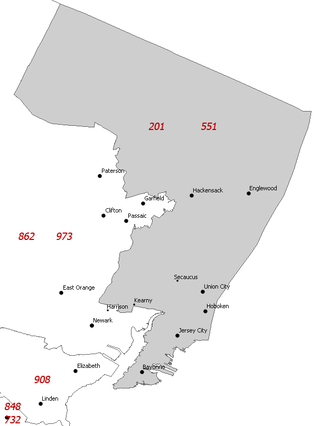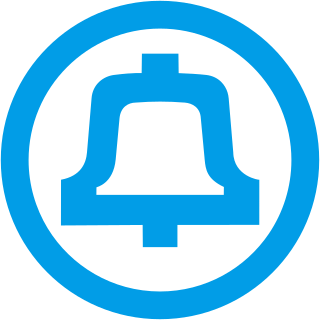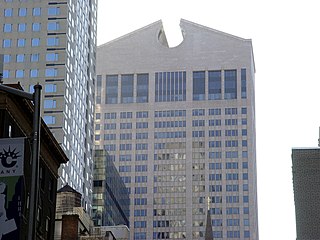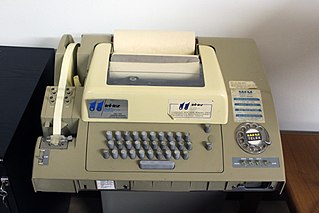
Dual-tone multi-frequency signaling (DTMF) is a telecommunication signaling system using the voice-frequency band over telephone lines between telephone equipment and other communications devices and switching centers. DTMF was first developed in the Bell System in the United States, and became known under the trademark Touch-Tone for use in push-button telephones supplied to telephone customers, starting in 1963. DTMF is standardized as ITU-T Recommendation Q.23. It is also known in the UK as MF4.
Direct distance dialing (DDD) is a telecommunications service feature in North America by which a caller may, without operator assistance, call any other user outside the local calling area. Direct dialing by subscribers typically requires extra digits to be dialed as prefixes to the directory telephone number of the destination. International Direct Distance Dialing (IDDD) extends the system beyond the geographic boundaries of the North American Numbering Plan (NANP).

The Automatic Voice Network was a worldwide American military telephone system. The system was built starting in 1963, based on the Army's existing Switch Communications Automated Network (SCAN) system.

The North American Numbering Plan (NANP) is a telephone numbering plan for twenty-five regions in twenty countries, primarily in North America and the Caribbean. This group is historically known as World Zone 1 and has the telephone country code 1. Some North American countries, most notably Mexico, do not participate with the NANP.
The Pacific Bell Telephone Company (Pac Bell) is a telephone company that provides telephone service in California. The company is owned by AT&T through AT&T Teleholdings, and, though separate, is now marketed as “AT&T”. The company has been known by a number of names during which its service area has changed. The formal name of the company from the 1910s through the 1984 Bell System divestiture was The Pacific Telephone and Telegraph Company. As of 2002, the name “Pacific Bell” is no longer used in marketing, although Pacific Bell is still the holder of record for the infrastructure of cables and fiber through much of California.

Area codes 201 and 551 are telephone area codes in the North American Numbering Plan (NANP) in the U.S. State of New Jersey. Area code 201 was the area code assigned to the entire state of New Jersey in 1947, when the North American area code system was formed. After splits in 1956, 1991, and 1997, it is assigned to the northeastern portion of the state, including most of Hudson and Bergen counties, bordering New York City. Major cities in the numbering plan area include Bayonne, Jersey City, Hoboken, Hackensack, Secaucus and Englewood. Area code 551 was added to this numbering plan area in 2001 in formation of an overlay. Area code 201 is also assigned for wireless services in some rate centers in the 973 and 908 numbering plan areas, such as Newark, Morristown, and New Brunswick.
Seven-digit dialing is a telephone dialing procedure customary in some territories of the North American Numbering Plan (NANP) for dialing telephone numbers in the same numbering plan area (NPA). NANP telephone numbers consist of ten digits, of which the leading three are the area code. In seven-digit dialing it is not necessary to dial the area code. The procedure is also sometimes known as local format or network format.

Tele-Communications, Inc. (TCI) was a cable television provider in the United States, and for most of its history was controlled by Bob Magness and John Malone.
In telecommunications, a long-distance call (U.S.) or trunk call is a telephone call made to a location outside a defined local calling area. Long-distance calls are typically charged a higher billing rate than local calls. The term is not necessarily synonymous with placing calls to another telephone area code.
Rochester Telephone Corporation was a company that provided local telephone service to Rochester, New York. The company was founded in 1920 as a merger of Rochester Telephonic Exchange and Rochester Telephone Company. In 1995 the company became Frontier Corporation, trading on the NYSE under the FRO symbol. Ownership passed to Global Crossing in 1999, and then, in 2001, to Citizens Utilities Corporation, which later changed its name to Frontier Communications.
Northwestel Inc. is a Canadian telecommunications company that is the incumbent local exchange carrier (ILEC) and long-distance carrier in the territories of Yukon, the Northwest Territories, Nunavut, and part of northern British Columbia and northern Alberta. Originally established in 1979 by the Canadian National Railway from CN's northern telecommunications assets, it has been owned by BCE Inc. since 1988.

The monopoly position of the Bell System in the U.S. was ended on January 8, 1982. AT&T Corporation proposed by in a consent decree to relinquish control of the Bell Operating Companies, which had provided local telephone service in the United States. AT&T would continue to be a provider of long-distance service, while the now-independent Regional Bell Operating Companies (RBOCs), nicknamed the "Baby Bells", would provide local service, and would no longer be directly supplied with equipment from AT&T subsidiary Western Electric.

Verizon New Jersey, Inc., formerly New Jersey Bell Telephone Company, is the Bell Operating Company serving the U.S. state of New Jersey. In 1984, the Bell System Divestiture split New Jersey Bell off into a Regional Bell Operating Company, along with the 21 other BOCs AT&T had a majority stake in. On January 1, 1984, New Jersey Bell became part of Bell Atlantic.
SBC Long Distance LLC is a long-distance telephone company owned by AT&T that does business as AT&T Long Distance. SBC Long Distance competes with other long-distance providers who provide service within some of the Bell Operating Company service boundaries of AT&T. SBC Long Distance is a separate subsidiary than AT&T Communications, the incumbent long-distance carrier for most of the country acquired in the SBC merger with AT&T.
The L-carrier system was one of a series of carrier systems developed by AT&T for high-capacity transmission for long-distance communications. Over a period from the late 1930s to the 1970s, the system evolved in six significant phases of development, designated by Bell System engineers as L-1 through L-5, and L-5E. Coaxial cable was the principal transmission medium in all stages, initially lending the system another description i.e. the coaxial system. It was the successor to a series of previous carrier systems, typically identified by capital letters. In the 1960s, the system was hardened against the dangers of the Cold War using complete placement of all terminal and repeater equipment in hardened underground vaults.

The Bell System was a system of telecommunication companies, led by the Bell Telephone Company and later by the American Telephone and Telegraph Company (AT&T), that dominated the telephone services industry in North America for over 100 years from its creation in 1877 until its antitrust breakup in 1983. The system of companies was often colloquially called Ma Bell, as it held a vertical monopoly over telecommunication products and services in most areas of the United States and Canada. At the time of the breakup of the Bell System in the early 1980s, it had assets of $150 billion and employed over one million people.
The original North American area codes were established by the American Telephone and Telegraph Company (AT&T) in 1947, after the demonstration of regional Operator Toll Dialing during the World War II period. The program had the goal of speeding the connecting times for long-distance calling by eliminating intermediary telephone operators. Expanding this technology for national use required a comprehensive and universal, continent-wide telephone numbering plan.

AT&T Corporation, an abbreviation for its former name, the American Telephone and Telegraph Company, was an American telecommunications company that provided voice, video, data, and Internet telecommunications and professional services to businesses, consumers, and government agencies.

Telex is a telecommunication service that provides text-based message exchange over the circuits of the public switched telephone network or by private lines. The technology operates on switched station-to-station basis with teleprinter devices at the receiving and sending locations. Telex was a major method of sending text messages electronically between businesses in the post–World War II period. Its usage went into decline as the fax machine grew in popularity in the 1980s.
The history of AT&T dates back to the invention of the telephone. The Bell Telephone Company was established in 1877 by Alexander Graham Bell, who obtained the first US patent for the telephone, and his father-in-law, Gardiner Greene Hubbard. Bell and Hubbard also established American Telephone and Telegraph Company in 1885, which acquired the Bell Telephone Company and became the primary telephone company in the United States. This company maintained an effective monopoly on local telephone service in the United States until anti-trust regulators agreed to allow AT&T to retain Western Electric and enter general trades computer manufacture and sales in return for its offer to split the Bell System by divesting itself of ownership of the Bell Operating Companies in 1982.















